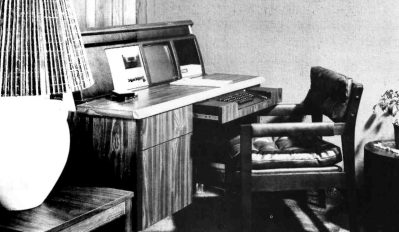People argue about the first use of the computer desktop metaphor. Apple claims it. Xerox probably started it. Yet, when I think of computer desktops, I think of the NOVAL 760. Not a household name, to be sure, but a big ad spread in a June 1977 Byte magazine was proud to introduce it. At $2995, we doubt many were sold, but the selling point was… well… it was built into a “handsome wood desk, designed to compliment any decor.” The desk folded down when you were not using the computer, and the keyboard recessed into a drawer.
The computer itself was no slouch for 1977, but nothing you couldn’t find elsewhere. An 8080, speed unspecified, had 16 kB of RAM and 3 kB of PROM. There was also a display with a few kB of memory hanging around, too. And just in case you were worried, the bottom of the page entitled “The Ultimate in Home Computers” reads, “The NOVAL 760 COMPUTER. A fully-assembled, fully-tested personal computer … not a kit!” Of course, for us, that’s not really a selling point. If you wonder why the computer was memory limited, this is the time that Extensys bragged in an ad: 64 kB for $1495! If you ordered one, you could have it in 15 to 30 days, too!
There were options for more memory, and it wasn’t clear how many of the I/O devices in the ad were actually included in the advertised price. Some of the devices seemed very specialized, so we are guessing the basic system didn’t include some of them.
Input/Output

According to the ad, you did get a lot of I/O devices, apparently, and they seemed to understand that software was the key to selling computers, although there wasn’t much of it about yet in 1976. The computer had a 12-inch monochrome monitor with 28 lines of 32 characters. If you used an external color monitor, the display could handle it. Don’t get too excited, though. An EPROM held four “schemes” of eight pairs of image and background colors. You could select any of the four schemes you wanted, but if you wanted anything else, you needed to burn an EPROM.
For mass storage, the computer had a “professional” mag tape system: a PhiDeck that could do about 2,500 bits per second. There was an audio tone generator that could have been anything from a buzzer to a crude sound card. A paper tape reader and, apparently, an EPROM burner — maybe for the color schemes, but we doubt they included an eraser. There was also a film reader, but it isn’t clear from the ad if that could scan film images (doubtful) or if it was some sort of read-only mass storage that they planned to use for distributing software.
Diskless
Notably lacking was a disk drive. They don’t mention a printer in the ad, but one was visible in the pictures — we guess it might have been an add-on and not included in the $3,000 price tag. The standard printer was an LRC printer that printed a raster image generated by the computer itself and matched the 32-character width of the monitor. Forward-looking but slow on a 1977-era 8080. Even the fact that the I/O drivers were in a ROM (what we would call a BIOS) and didn’t require fixed addresses to call was a selling point in 1977.
Games

Interestingly, the company couldn’t decide if it was a high-end business workstation or a game system. It had “dual hand-held keyboards for competitive game action, for the first time on a home computer,” according to the ad. They mention TELEMATH, a game where the computer presents math problems to two players, scoring for the first player to answer correctly.
They had some form of games from Gremlin Industries, apparently “the leader in commercial computer videographic and wall games” in 1977. We know them better as “a company bought by Sega.” Apparently, Gremlin was a “sister company,” although we don’t know the history there. We doubt Sega acquired it along with Gremlin since there is little information about the company after a big splash in 1977.
Assembly Required After All
The other software they seemed proud of was the editor assembler which was interactive and caught errors immediately. Back then, no one was sure what was happening with the computer industry. Maybe people were going to all learn assembly language. Maybe PCs would be sold in furniture stores. Maybe.
We wonder how many of these were ever out in the world. At least one still lives at the Computer History Museum. We don’t know exactly what happened to the company or if someone still has one of these in their spare bedroom collecting dust.
While computers did wind up in every home, it wasn’t like we imagined in 1977. At least they were closer than we were in 1962.The Noval was a big step up from a desktop computer of 1965.
Source link










Leave a Reply